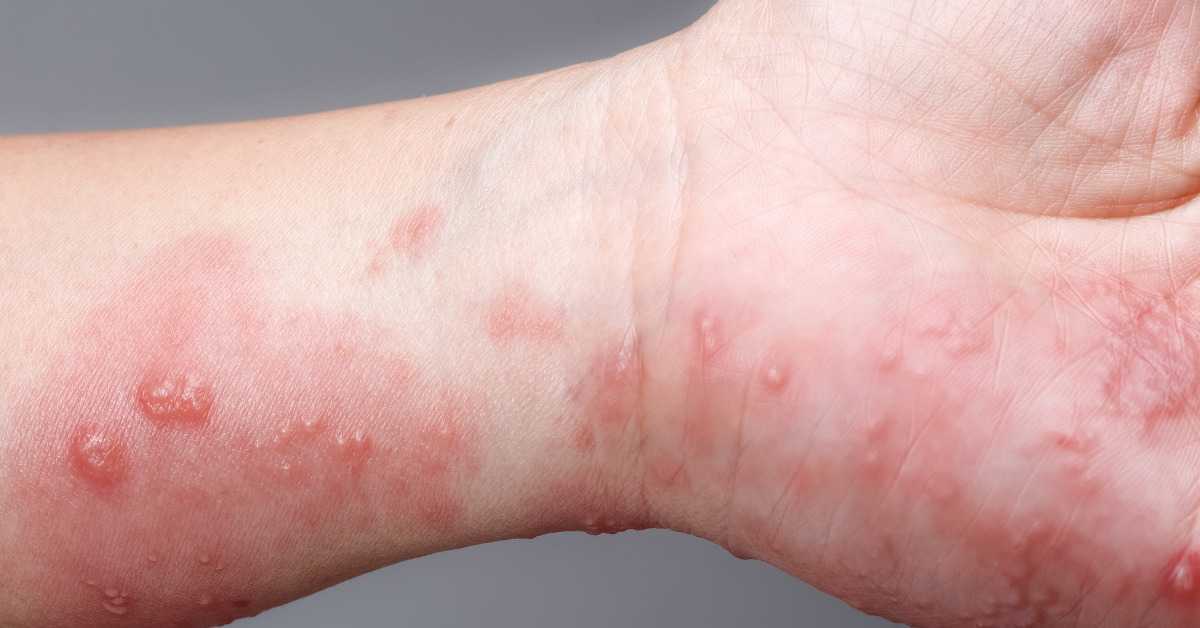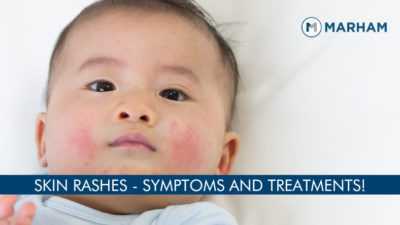Skin rashes are a common occurrence and almost all people get them. They are easily treatable and usually are not a reason to be alarmed. However, if you frequently get skin rashes it can indicate a serious problem. Check out some of the most common skin rash types and their treatments in this health blog.
What is a Skin Rash?
According to the American Dermatology Association (ADA), rashes can take the form of blotches, welts, or blisters. They can be red, itchy, scaly, or dry; and they can arise in a single region of skin or all over the body.


5 Skin Rash Types:
The five common skin rash types are given below:
1. Contact dermatitis
Have you ever gotten a rash by touching things like cosmetics, scents, jewelry, or plants? If yes, you might have a contact dermatitis rash. It is quite common and usually appears after a few days of being exposed to allergens.
It is an itchy rash generated by direct touch with a chemical or an allergic reaction. But, the good news is that it can not spread to other areas.
Symptoms:
- has apparent boundaries
- might seem red on lighter skin tones
- may have blisters that bleed, ooze, or become crusty
- often itchy, scaly, or raw
To properly treat contact dermatitis, you must first identify and prevent the source of your allergy, by doing this the rash will usually go away in 2 to 4 weeks.
It is recommended to use a cold, moist towel to soothe your skin, as well as other self-care measures.
2. Covid Skin Rash
The COVID Skin rash might appear at any time during COVID-19. In some cases, it appears shortly after you are infected, whereas, in others, it appears several days later.
COVID-19 rash can persist for 2 to 12 days. Most people develop a rash for 8 days on average. Rashes on the toes, on the other hand, might persist for 10 to 14 days.
“Among extrapulmonary signs associated with COVID-19, dermatological manifestations have been increasingly reported in the last few months,” says research.
Symptoms:
- typically discolored, may look red, pink, purple, ashy grey, or dark brown
- the affected area may appear swollen or puffy
- Itching
It’s a good idea to consult a doctor if you notice an inexplicable rash. The only way to know for certain if your rash is caused by COVID-19 is to undergo a COVID-19 test.
3. Hand, foot, and mouth disease
Another common skin rash type is Hand-foot-and-mouth disease which is a contagious viral infection that primarily affects young children. Coxsackievirus is the most prevalent cause of this skin disease.
Symptoms:
- Fever
- Sore throat
- Painful, blister-like lesions on the tongue, gums, and inside of the cheeks
- Feeling sick
- Fussiness in infants and toddlers
- Loss of appetite
- A rash on the palms, soles, and sometimes the buttocks
Handwashing frequently and avoiding close contact with people who have hand, foot, and mouth disease may help reduce your child’s risk of infection.
Read this article to know the best creams for fungal infections.
4. Diaper rash
Diaper rash is often caused by irritation, infection, or allergy. It causes a baby’s skin to become inflamed, red, scaly, and painful. In the majority of children, the rash will go away with simple diaper changes.
“Diaper rash is the most common dermatitis found in infancy. Prevalence has been variably reported from 4-35% in the first 2 years of life,” according to Medscape.
Some common causes of diaper rash are keeping the diaper on for too long, an infection caused by germs, or allergies in babies with sensitive skin.
Symptoms:
- Inflamed skin of buttocks, thighs, and genitals
- Discomfort, fussiness, or crying
- Sores
- Itchy, tender skin
The best diaper rash treatment is to keep your baby’s skin as clean and dry as possible. If home therapy does not clear up the rash, see a doctor.
5. Skin rash due to heat
Heat rash, commonly known as prickly heat and miliaria, affects adults and children as well, especially in hot, humid weather.
Heat rash normally disappears after the skin cools down. But, severe cases of the illness may necessitate medical attention.
Symptoms:
- Clear blisters or small red dots, in the skin, folds, on the face, or in the diaper region of newborns
- an uncomfortable itch and prickling feeling
- redness and minor swelling of the afflicted area
Heat rash usually fades away on its own. However, there are medications available from a drugstore to alleviate itching problems.
How to Take Care of Rashes at Home?
You can follow the following at-home treatments for rashes:
- Stop using any cosmetics or lotions that cause a reaction.
- Allow as much air as possible to reach the afflicted region.
- Calamine-medicated lotion can be used to treat poison ivy, oak, or sumac, as well as other kinds of contact dermatitis.
- Avoid scrubbing your skin, and instead, use soft cleansers.
- Avoid directly putting cosmetic lotions or ointments on the rash.
- Cleaning should be done with warm water.
- Pat dry rather than rubbing.
- Use hydrocortisone cream (1%), which is available without a prescription.
When to Consult a Dermatologist for Skin Rash?
Consult a dermatologist, if a rash or other skin condition covers more than 10% of your body, especially if you have a fever, joint pains, muscle discomfort, difficulty swallowing, or trouble sleeping.
Can’t Find the App?
| Android | IOS |
|---|---|
  |
  |
FAQs
How can you tell if a rash is serious?
You can tell if your rash is severe if it is all over your body, is spreading quickly, forms painful blisters, gets, infected, or you develop a fever. In any of these cases, consult a skin specialist.
How do you treat skin rashes?
You can treat your skin rashes by using gentle cleansers, avoiding cosmetics or creams that cause allergies, allowing the rash to be exposed to air, and using OTC ointments.
What does a stress rash look like?
They frequently appear as swollen, puffy, red, pink, or flesh-colored splotches and may resemble insect bites or raised red lumps at times. If they do not go away on their own, see a doctor.

